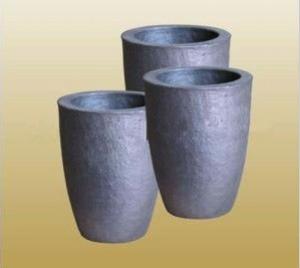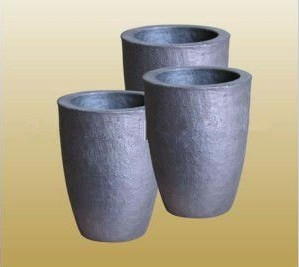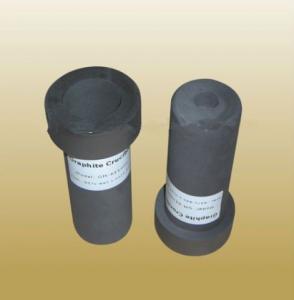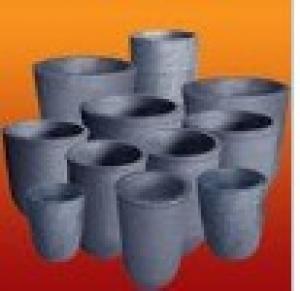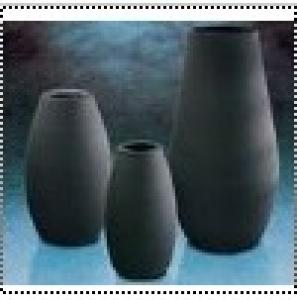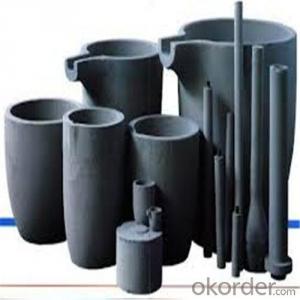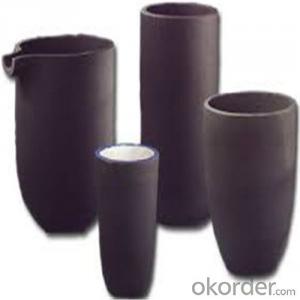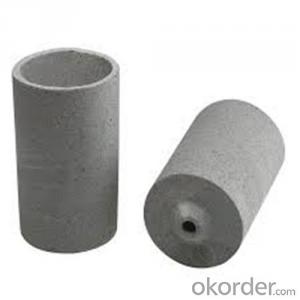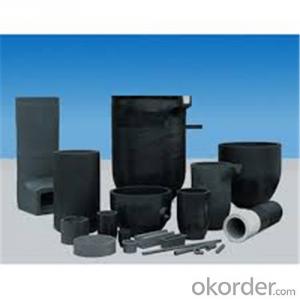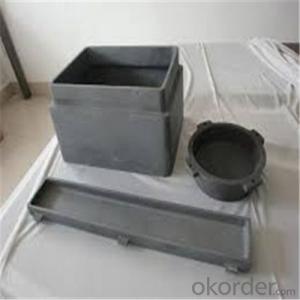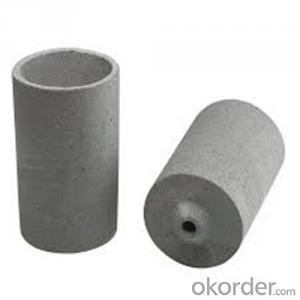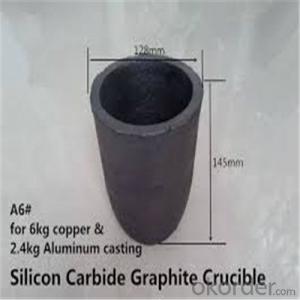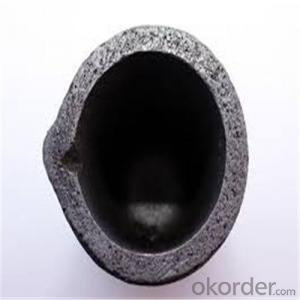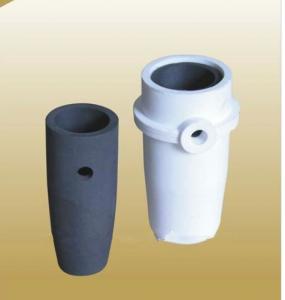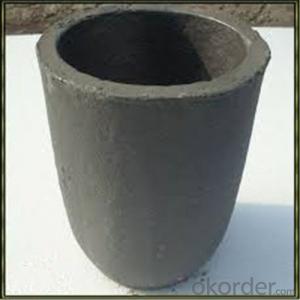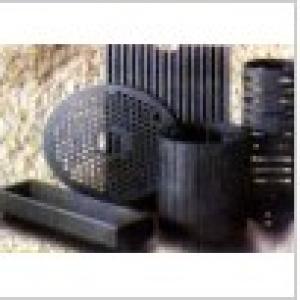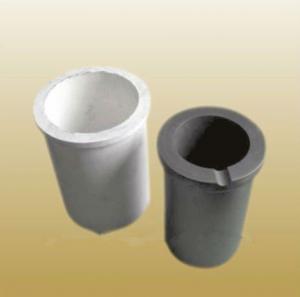Silicon Carbide Graphite Crucible Amazon
- Loading Port:
- China Main Port
- Payment Terms:
- TT or LC
- Min Order Qty:
- 5 Pieces pc
- Supply Capability:
- 10000 Pieces per Month pc/month
OKorder Service Pledge
Quality Product, Order Online Tracking, Timely Delivery
OKorder Financial Service
Credit Rating, Credit Services, Credit Purchasing
You Might Also Like
Detailed Product Description
1. Top quality crucibles offer consistent performance when melting ferrous, onferrous and precious metals.
2. Good thermal conductivity keeps metal from cooling too rapidly. Made of natural flake graphite and silicon carbide bonded with find clay, lined with mullite for long life.
Specification:
| NO | Modle Number | Up Dia(mm) | Down Dia(mm) | High(mm) |
| 1 | 80# | 300 | 175 | 358 |
| 2 | 100# | 326 | 200 | 366 |
| 3 | 120# | 345 | 195 | 383 |
| 4 | 150# | 370 | 192 | 430 |
| 5 | 200# | 398 | 220 | 490 |
| 6 | 250# | 450 | 240 | 550 |
| 7 | 300# | 470 | 240 | 573 |
| 8 | 350# | 485 | 275 | 610 |
| 9 | 400# | 520 | 282 | 648 |
| 10 | 500# | 540 | 313 | 698 |
| 11 | 800# | 630 | 335 | 720 |
| 12 | 1000# | 640 | 380 | 773 |
- Q: How do you determine the appropriate crucible diameter for a specific application?
- The appropriate crucible diameter for a specific application is typically determined by considering factors such as the desired sample size, the melting or reaction temperature, the thermal conductivity of the material being heated, and the available heating equipment. Additionally, the crucible should have sufficient room for the sample to expand during heating without overflowing. It is important to consult relevant literature, technical specifications, or seek expert advice to ensure the appropriate crucible diameter is selected for the specific application.
- Q: Can a graphite crucible be used for nickel melting?
- Yes, a graphite crucible can be used for nickel melting. Graphite crucibles are commonly used in high-temperature applications, including the melting of metals like nickel. Graphite has a high melting point, excellent thermal conductivity, and good resistance to chemical corrosion, making it suitable for melting and containing nickel. Additionally, graphite crucibles offer good heat transfer, allowing for efficient and uniform melting of the metal. However, it is important to ensure that the graphite crucible is specifically designed for high-temperature applications and is compatible with the melting temperature of nickel to avoid any potential issues or damage.
- Q: How do you prevent graphite crucibles from cracking due to thermal stress?
- To prevent graphite crucibles from cracking due to thermal stress, there are several measures that can be implemented: 1. Preheating: Before using a new graphite crucible, it is important to preheat it gradually. This helps to eliminate any moisture or volatile components that may be present in the crucible, reducing the risk of thermal shock. 2. Avoid sudden temperature changes: Rapid and extreme temperature changes can cause thermal stress, leading to cracking. To prevent this, it is essential to heat and cool the crucible gradually. A gradual heating and cooling process allows the crucible to expand and contract uniformly, reducing the risk of cracking. 3. Use proper heating techniques: When heating the crucible, it is important to use appropriate heating techniques such as applying a uniform heat source. Uneven heating can lead to localized expansion and contraction, increasing the chances of cracking. 4. Maintain proper temperature limits: Each type of graphite crucible has a specific temperature limit. Exceeding this limit can result in thermal stress and eventual cracking. It is crucial to operate within the recommended temperature range to prevent damage. 5. Handle with care: Graphite crucibles are delicate and can be easily damaged if mishandled. To prevent cracking, it is important to handle them with care, avoiding any sudden impacts or rough handling. 6. Regular inspection: Regularly inspecting the crucibles for any signs of wear, cracks, or damage is vital. If any issues are identified, it is best to replace the crucible immediately to prevent any further damage or potential accidents. By following these preventive measures, the risk of thermal stress and cracking in graphite crucibles can be significantly reduced, ensuring their long-lasting performance.
- Q: How to select and use the carbon graphite for machinery? What items should we pay attention to?
- Selection must be based on the working conditions of the equipment, taking into account the pressure, wire speed, medium, and grinding materials and other factors, if necessary, after the test selected appropriate.
- Q: Does the smelting of nonferrous metals, graphite crucible and cast iron crucible which is easy to use?
- The pollution of carbon to aluminum alloy and copper alloy should be less than that of iron to aluminium alloy and copper alloy, but the iron crucible is durable and easy to use
- Q: How do you determine the appropriate crucible capacity for a specific application?
- To determine the appropriate crucible capacity for a specific application, there are several factors that need to be considered. Firstly, you need to consider the quantity of material that needs to be melted or heated in the crucible. This can be determined by the volume or weight of the material. It is important to choose a crucible size that can accommodate the material without overflowing or being too empty, as both scenarios can affect the heating efficiency and the quality of the final product. Secondly, you need to consider the melting or heating temperature required for the specific application. Different materials have different melting points, and some may require higher temperatures than others. The crucible should have the capacity to withstand and maintain the desired temperature without cracking or deforming. Additionally, the duration of the application should be taken into account. If the application requires a prolonged period of melting or heating, it is important to choose a crucible size that can hold the material for the required duration without the need for frequent refilling or emptying. This ensures a continuous and efficient operation. Furthermore, the type of crucible material is also important in determining the appropriate capacity. Different materials have different thermal conductivity and compatibility with certain materials. It is crucial to choose a crucible material that is suitable for the specific application to prevent contamination or reaction between the crucible and the material being heated. Lastly, it is recommended to consult the manufacturer or supplier of the crucible for their recommendations. They have the expertise and knowledge to guide you in selecting the appropriate crucible capacity based on your specific application requirements. By considering these factors and seeking expert advice, you can determine the appropriate crucible capacity for your specific application, ensuring optimal performance and desired results.
- Q: What are the common defects found in graphite crucibles?
- Common defects found in graphite crucibles include cracks, chips, erosion, and oxidation. These defects can occur due to thermal shock, mechanical stress, chemical reactions, or prolonged use at high temperatures.
- Q: How do you prevent contamination from the graphite crucible during melting?
- To prevent contamination from the graphite crucible during melting, several measures can be taken. One approach is to ensure that the crucible is thoroughly cleaned and free from any impurities before use. Additionally, using high-quality graphite crucibles that are specifically designed for high-temperature applications can minimize the risk of contamination. It is also crucial to handle the crucible with clean and dry tools to avoid introducing foreign substances. Finally, maintaining a controlled and stable melting environment, such as using a protective atmosphere or vacuum, can further prevent contamination by preventing the reaction of the crucible with surrounding gases or materials.
- Q: What is the difference between the indirect method Zinc Oxide and the direct law Zinc Oxide?
- The direct method of Zinc Oxide in a variety of zinc ore or debris as raw material. Zinc Oxide and coke in the reaction when heating is reduced into metallic zinc by the steam, and then oxidation by oxygen in the air for Zinc Oxide, Zinc Oxide to remove most of the impurities. The direct method to obtain coarse particles, the product purity was 75%-99.5%.
- Q: The difference between atomic absorption pyrolytic graphite tube and common graphite tube
- Atomizer with different flame atomizer consists of three parts: atomizer, premixing chamber and burner. Features: easy operation and good reproducibility. Graphite furnace atomic device is a type of system will be placed in the pipe wall, graphite platform, carbon sample holes or graphite crucible with electric heating to a high temperature to achieve atomization. Tubular graphite furnace is the most commonly used atomization device. The atomization program is divided into drying, ashing, atomization and high temperature purification. The atomization efficiency is high: under the adjustable high temperature, the sample utilization rate is 100%. High sensitivity: the detection limit is 10-6~10-14. Small amount of sample: suitable for determination of refractory elements.
We are always keeping enlarging production scale, perfecting management system, and improving office facilities to expand our markets both at home and abroad.We sincerely welcome clients at home and abroad to come for negotiations.
1. Manufacturer Overview
| Location | Guangdong,China (Mainland) |
| Year Established | 2010 |
| Annual Output Value | |
| Main Markets | North America South America Eastern Europe Southeast Asia Africa Oceania Mid East Eastern Asia Western Europe |
| Company Certifications |
2. Manufacturer Certificates
| a) Certification Name | |
| Range | |
| Reference | |
| Validity Period |
3. Manufacturer Capability
| a) Trade Capacity | |
| Nearest Port | |
| Export Percentage | 61% - 70% |
| No.of Employees in Trade Department | |
| Language Spoken: | |
| b) Factory Information | |
| Factory Size: | 1,000-3,000 square meters |
| No. of Production Lines | Above 10 |
| Contract Manufacturing | OEM Service Offered |
| Product Price Range | |
Send your message to us
Silicon Carbide Graphite Crucible Amazon
- Loading Port:
- China Main Port
- Payment Terms:
- TT or LC
- Min Order Qty:
- 5 Pieces pc
- Supply Capability:
- 10000 Pieces per Month pc/month
OKorder Service Pledge
Quality Product, Order Online Tracking, Timely Delivery
OKorder Financial Service
Credit Rating, Credit Services, Credit Purchasing
Similar products
Hot products
Hot Searches
Related keywords
